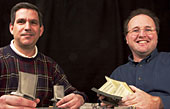AMES, Iowa -- Iowa State University's materials science program started with a 1906 directive from the Iowa Legislature to establish a course "of practical and scientific instruction and investigation in the art of clay working and ceramics."
And so the Iowa State College of Agriculture and Mechanic Arts set about teaching students, conducting research and otherwise helping Iowa's brick, tile and cement industries.
A century later the work of Iowa State's Department of Materials Science and Engineering has evolved to include high-tech research in advanced materials, informatics and nanotechnologies. But much of that work has the same practical, real-world application as the projects of 100 years ago.
A few examples:
- Brian Gleeson, a professor of materials science and engineering, and Daniel Sordelet, a scientist at the Department
of Energy's Ames Laboratory, won a prestigious 2005 R&D 100 Award for a coating made from a platinum-modified
nickel and aluminum alloy. That coating helps turbine blades hold up to the heat of jet engines.
- Vladimir Tsukruk, a professor of materials science and engineering, is working to develop tiny and lightweight
sensors using nanomembranes just a few billionths of a meter thick. Potential applications of the technology include
thermal, acoustic and chemical microsensors.
- Vitalij Pecharsky, a professor of materials science and engineering, is looking for a way to make hydrogen-powered
vehicles a reality. The problem is storing hydrogen fuel. A vehicle can't carry enough compressed hydrogen gas to get
very far. Pecharsky is looking for a hydrogen-rich solid fuel.
"From its beginnings as a program focusing largely on ceramics and the large brick and tile industry in Iowa to its modern day role developing groundbreaking new materials, this department has excelled in every way -- in the quality of its teaching programs, in its research accomplishments, and in the development and application of modern technology," wrote Iowa State President Gregory Geoffroy in a letter to the department's faculty and staff.
Mark Kushner, the dean of Iowa State's College of Engineering, said he expects the department's faculty, staff and graduates will keep on developing and applying modern technology.
"From nondestructive evaluation to superhard alloys, evidence of their contributions is all around us," Kushner said. "I have every expectation the department will continue to be a source of innovation in developing the materials and techniques that will improve the quality of life worldwide."
Mufit Akinc, professor and chair of Materials Science and Engineering, likes to point out some of the numbers that define the department: It is one of the smallest departments in the College of Engineering but last fiscal year it attracted about $17 million in research funding, about one-third of the college's research dollars. Four of the department's faculty members have been named distinguished professors. The faculty's teaching evaluations average 4.1 to 4.2 on a scale of 5. And the department's enrollment is about 180 undergraduate students, 90 graduate students and 10 post-doctoral students.
But there's one number the department needs to work on, Akinc said. The department doesn't have a single endowed chair or professorship to help it retain and attract outstanding faculty.
Even so, he's excited about what the department's faculty members have been doing for their students.
Akinc teaches an orientation course to the department's freshmen, students "who don't know what materials science is all about," he said. "But four years later when we see them at graduation they are challenging us on scientific and engineering topics. That is a tremendous achievement for them and for us."
The department will celebrate its centennial with the theme, "Making Materials Matter for 100 Years." The celebration includes a distinguished lecture series, two symposia, activities during Iowa State's spring VEISHEA celebration and an awards banquet.
